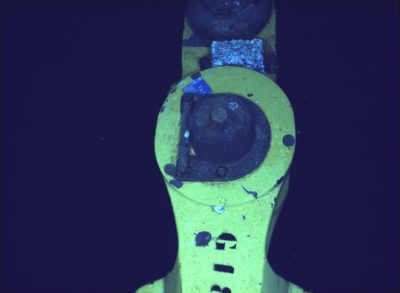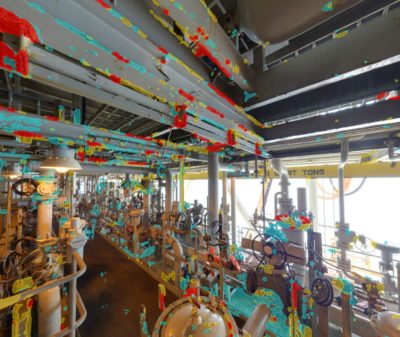As its evocative name suggests, Abyss Solutions is a company taking AI to places where humans can’t — or shouldn’t — go.
The brainchild of four University of Sydney scientists and engineers, six years ago the startup set out to improve the maintenance and observation of industrial equipment.
It began by developing advanced technology to inspect the most difficult to reach assets of urban water infrastructure systems, such as dams, reservoirs, canals, bridges and ship hulls. Later, it zeroed in on an industry that often operates literally in the dark: offshore oil and gas platforms.

A few years ago, Abyss CEO Nasir Ahsan and CTO Suchet Bargoti were demonstrating to a Houston-based platform operator the insights they could generate from the image data collected by its underwater Lantern Eye 3D camera. The camera’s sub-millimeter accuracy provides a “way to inspect objects as if you’re taking them out of water,” said Bargoti.
An employee of the operator interrupted the meeting to describe an ongoing problem the company was having with their topside equipment that was decaying and couldn’t be repaired sufficiently. Once it was clear that Abyss could provide detailed insight into the problem and how to solve it, no more selling was needed.
“Every one of these companies is dreading the next Deepwater Horizon,” said Bargoti, referencing the 2010 incident in which BP spilled nearly 5 million barrels of oil into the Gulf of Mexico, killing 11 people and countless wildlife, and costing the company $65 billion in cleanup costs and fines. “What they wanted to know is, ‘Will your data analytics help us understand what to fix and when to fix it?’”
Today, Abyss’s combination of NVIDIA GPU-powered deep learning algorithms, unmanned vehicles and innovative underwater cameras is enabling platform operators to spot faults and anomalies such as corrosion on equipment above and below the water and address it before it fails, potentially saving millions of dollars and even a few human lives.
During the COVID-19 pandemic, the stakes have risen. Offshore rigs have emerged as hotbeds for the spread of the virus, forcing them to adopt strict quarantine procedures that limit the number of people onsite in order to reduce the disease’s spread and minimize interruptions.
Essentially, this has sped up the industry’s digital transformation push and fueled the urgency of Abyss’ work, said Bargoti. “They can’t afford to have these things happening,” he said.

Better Than Human Performance
Historically, inspection and maintenance of offshore platforms and equipment has been a costly, time-consuming and labor-intensive task for oil and gas companies. It often yields subjective findings that can result in missed needed repairs and unplanned shutdowns.
An independent audit found that Abyss’ semantic segmentation models are able to detect general corrosion with greater than 90 percent accuracy, while severe corrosion is identified with greater than 97 percent accuracy. Both are significant improvements over human efforts, and also have outcompeted other AI companies in the audit.
What’s more, Abyss says that its oil and gas platform clients report reductions in operating costs by as much as 25 percent thanks to its technology.
Training of Abyss’s models, which rely on many terabytes of data (each platform generates about 1TB a day), occurs on AWS instances running NVIDIA T4 Tensor Core GPUs. The company also uses the latest versions of CUDA and cuDNN in conjunction with TensorFlow to power deep learning applications such as image and video segmentation and classification, and object detection.
Bargoti said the company also is working with the NVIDIA Jetson TX2 module and TensorRT software to condense its models so they can run on their unmanned vehicles in real time.
Most of the data can be processed in the cloud because of the slowness of the corrosion process, but there are times when real-time AI is needed onsite, such as when a robotic vehicle needs to make decisions on where to go next.
Taking Full Advantage of Inception
As a member of NVIDIA Inception, a program to help startups working in AI and data science get to market faster, Abyss has benefited from a try-before-you-buy approach to NVIDIA tech. That’s allowed it to experiment with technologies before making big investments.
It’s also getting valuable advice on what’s coming down the pipe and how to time its work with the release of new GPUs. Bargoti said NVIDIA’s regularly advancing technology is helping Abyss squeeze more data into each compute cycle, pushing it closer to its long-term vision.
“We want to be the intel in these unmanned systems that makes smart decisions and pushes the frontier of exploration,” said Bargoti. “It’s all leading to this better development of perception systems, better development of decision-making systems and better development of robotics systems.”
Abyss is taking a deep look at a number of additional markets it believes its technology can help. The team is taking on growth capital and rapidly expanding globally.
“Continuous investment in R&D and innovation plays a critical role in ensuring Abyss can provide game-changing solutions to the industry,” he said.